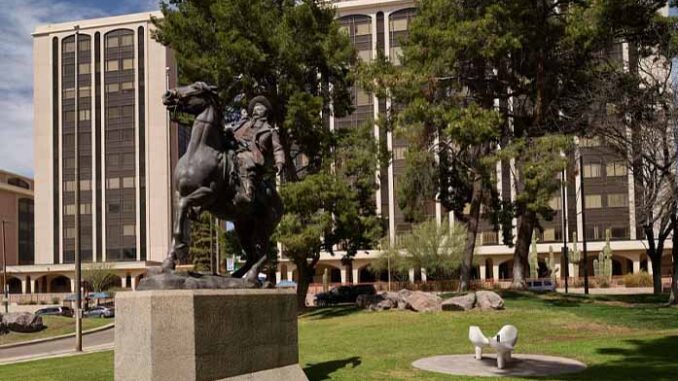
If buzzwords were effective at urban renewal, Tucson would be the most prosperous city in the nation.
A recent news story from 13 News was about the widening of Grant Rd. between Tucson Blvd. and Alvernon Way. It quoted some local residents on what they would like to see along the stretch.
The comments included all of the de rigueur urban planning buzzwords and platitudes, such as walkability, fresh food markets, high density, sustainability, and a partridge in a pear tree.
Sorry, my Italian emotions got the best of me on the last one.
The story didn’t quote any clichés about the glories of public transit, probably because bus service is already available and free—free to riders but not to taxpayers. The free rides are a mixed blessing. On the one hand, they give poor residents a transportation option if they don’t own a car; on the other, they allow bad guys to circulate from one neighborhood to the next.
A resident got to the nub of the problem with this: “If you live in a food desert and you live on a street that looks terrible and is not safe, you’re going to stay in your house all day.”
Well, the area of Alvernon and Grant is certainly not safe. It ranks near the top in the city for crime. And Grant is certainly ugly and in dire need of beautification, as is the case for scores of arteries in the city (and surrounding county). Here’s a photo of Grant:
Source: 13 News, Tucson
I don’t know enough of the history of Tucson to understand why the streets were designed to be so ugly or allowed to become so ugly. Perhaps the same sadism was at work among city government and business leaders that has kept the city so poor, crime-ridden, and adverse to economic development and prosperity.
A resident is quoted in the article about the area of Tucson and Grant being more walkable than the area of Grant to the east. Well, years ago, I used to walk both areas, as well as most of center city, many, many times. All of it was walkable, in the sense that I could move my legs to propel myself down the streets. But it was dangerous, seedy, and depressing. For one thing, even where there were sidewalks in fairly good condition without deranged people wandering about and litter lying about, the sidewalks were dangerously close to the street, due to much of the city being designed without adequate setbacks between the street and sidewalks and buildings.
My sense is that sleazy real estate developers in polyester suits and bolo ties were allowed to get away with murder during Tucson’s growth spurt 50 years ago. I exaggerate. Actually, they were allowed to join local politicians in making Tucson one of the most dangerous cities for pedestrians.
A resident claims in the news story that Grant is a food desert, although there is a Walmart Neighborhood Market at Grant and Alvernon, a Sandyi Oriental Market at Pima and Columbus, and a Whole Foods at Speedway and Columbus—all within walking distance.
There are also close-by restaurants: Culinary Dropout and Postino are at Grant and Tucson, Bobo’s is near Grant and Country Club, Robert’s is at Grant and Edith, and Noodleholics is at Grant and Palo Verde.
Regarding Whole Foods, it borders the wealthy enclave known as the Sam Hughes neighborhood, the home of many highly-paid faculty and functionaries from the University of Arizona, which is in the midst of a financial crisis, in spite of greedily participating in the tuition loan scam and gorging on student debt.
Priuses, Teslas, Volvos and Subarus abound in the Sam Hughes neighborhood. Judging by political signs in front yards, the residents are left of Berkeley and purport to care about social justice and diversity. Yet they live like members of the Politburo of the former Soviet Union, who had special stores, dachas, cars, and schools not available to the proletariat.
A resident on Grant wishes that her neighborhood had a park. She’s operating under an old paradigm in which parks were a positive. In today’s Tucson and many other U.S. cities, parks have become a negative, due to being overrun by the homeless, er, unhoused, and becoming centers of drug dealing and other crimes.
Allow me to digress with a rant: The U.S. has spent trillions in trying to democratize countries that can’t be democratized, and will probably spend another trillion on rebuilding Gaza when the war ends there. Yet many American cities are marked by squalor and by humans living and dying on the street like animals.
Tucson, like many cities in the U.S., has bought into the nostrums of the supposed urban planning guru Richard Florida. His schtick was that cities should be gentrified to attract the professional class, should be walkable, and should have plenty of hip restaurants and bars. Late to the party, downtown Tucson is being redeveloped by means of a special redevelopment district, a district that initially wasted $200 million of taxpayer money—this in a city that has a poverty rate twice the national average.
I’m not making this up: The district recently gave $60,000 to a downtown smoke shop for the installation of a sprinkler system, and it gave something like $200,000 to a restaurant to tear down a wall. Of course, such expenditures are subsidized indirectly but certainly by outlying neighborhoods and their neighborhood businesses.
Amazingly, neighborhood taxpayers have not stormed downtown with pitchforks.
Neither the widening of Grant nor the turning of downtown into a Richard Florida paradise will address the root problem of the City of Tucson and the surrounding Pima County—namely, that they’ve been run for decades by a hidebound political monopoly. Exacerbating this problem is the fact that a whopping 36 percent of the metropolis is unincorporated county; that is, it is governed by a level of government that is better suited for rural areas than urban/suburban ones.
The poor City of Tucson comprises about 52 percent of the metropolis. When added to the 36 percent of the metropolis that is unincorporated county, the total is 88 percent. This means that 88 percent of the metropolis is at a serious social, economic and political disadvantage and will remain so as long as voters tolerate the status quo.
These are facts, not buzzwords.
A nonpartisan author and activist, Mr. Cantoni can be reached at craigcantoni@gmail.com.
